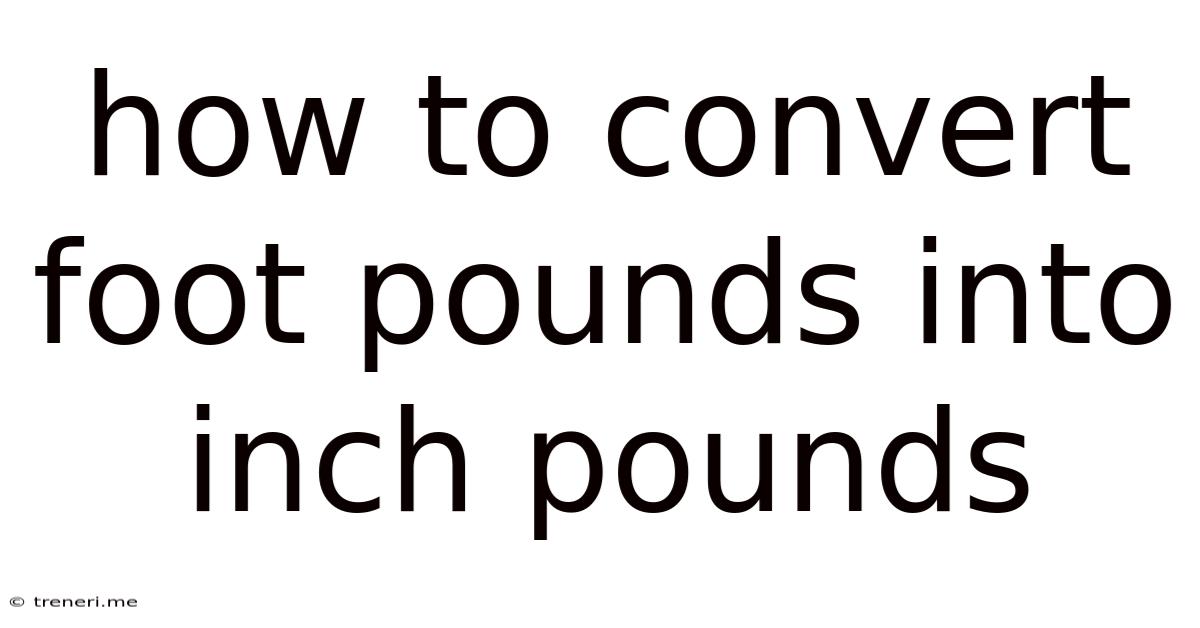How To Convert Foot Pounds Into Inch Pounds
Treneri
May 10, 2025 · 4 min read

Table of Contents
How to Convert Foot-pounds into Inch-pounds: A Comprehensive Guide
Converting units is a fundamental task in many fields, from engineering and physics to everyday tasks. Understanding how to convert units ensures accuracy and facilitates seamless communication across different measurement systems. This comprehensive guide focuses specifically on converting foot-pounds (ft-lb) to inch-pounds (in-lb), a common conversion needed in mechanics and torque calculations. We'll explore the method, provide practical examples, and delve into the underlying principles to ensure you master this conversion.
Understanding Foot-pounds and Inch-pounds
Before jumping into the conversion process, let's clarify what foot-pounds and inch-pounds represent. Both units measure torque, a rotational force that causes an object to rotate around an axis. The difference lies in the units used to express the distance from the axis of rotation (the lever arm) and the force applied.
-
Foot-pounds (ft-lb): This unit represents torque where the force is measured in pounds (lbs) and the lever arm (distance from the axis of rotation) is measured in feet (ft).
-
Inch-pounds (in-lb): This unit represents torque where the force is measured in pounds (lbs) and the lever arm is measured in inches (in).
The Conversion Factor: The Key to Success
The core of converting foot-pounds to inch-pounds lies in understanding the relationship between feet and inches. There are 12 inches in 1 foot. This simple fact provides the conversion factor we need. Since we're dealing with torque (force multiplied by distance), we simply multiply the foot-pound value by this factor.
The formula for the conversion is:
Inch-pounds (in-lb) = Foot-pounds (ft-lb) x 12
Step-by-Step Conversion Process
Let's break down the conversion process into easy-to-follow steps:
-
Identify the value in foot-pounds: Start with the torque value you need to convert, expressed in ft-lb. Let's use an example: 15 ft-lb.
-
Apply the conversion factor: Multiply the foot-pound value by 12 (the number of inches in a foot).
-
Calculate the result: In our example, 15 ft-lb x 12 = 180 in-lb.
Therefore, 15 ft-lb is equal to 180 in-lb.
Practical Examples: Real-World Applications
Let's explore some real-world scenarios where this conversion is crucial:
Example 1: Automotive Torque Wrench
Many automotive torque wrenches are calibrated in either foot-pounds or inch-pounds. Imagine you need to tighten a bolt to 20 ft-lb. To use a wrench calibrated in inch-pounds, you would need to convert:
20 ft-lb x 12 = 240 in-lb
Example 2: Engineering Calculations
In engineering design, calculations often involve torque. If a structural element is designed to withstand a torque of 50 ft-lb, converting this to inch-pounds might be necessary for compatibility with other design specifications:
50 ft-lb x 12 = 600 in-lb
Example 3: Mechanical Systems
Consider a mechanical system with a gear ratio. The torque output of the system might be initially calculated in foot-pounds. To determine the torque at a specific gear, conversion to inch-pounds could be essential to ensure precise calculations. For example, if a system outputs 10 ft-lb, and needs to be converted to inch-pounds, simply do:
10 ft-lb * 12 = 120 in-lb
Beyond the Basics: Advanced Considerations
While the basic conversion is straightforward, understanding some nuances can enhance your understanding:
-
Inverse Conversion: To convert from inch-pounds back to foot-pounds, simply divide the inch-pound value by 12. For example, 240 in-lb / 12 = 20 ft-lb.
-
Dimensional Analysis: A more rigorous approach to unit conversion involves dimensional analysis. This method ensures you're correctly multiplying and dividing units to arrive at the desired unit. In this case, we cancel out the feet unit by multiplying by (12 inches/1 foot), leaving us with inch-pounds.
-
Precision and Significant Figures: Remember to maintain the appropriate number of significant figures in your calculations. The accuracy of your conversion depends on the precision of your initial measurement.
Avoiding Common Mistakes
- Confusing units: Double-check that you're working with foot-pounds and not other torque units like Newton-meters (Nm).
- Incorrect multiplication/division: When converting, ensure you're multiplying by 12 (for ft-lb to in-lb) or dividing by 12 (for in-lb to ft-lb), not the other way around.
- Neglecting significant figures: Maintain consistent precision throughout your calculations to obtain a reliable result.
Conclusion: Mastering Foot-pounds to Inch-pounds Conversion
Converting foot-pounds to inch-pounds is a fundamental skill in various fields. By understanding the conversion factor, applying the steps outlined in this guide, and being mindful of potential pitfalls, you can confidently perform these conversions and ensure accuracy in your calculations. This ability improves your problem-solving skills and understanding of mechanical systems, making it a valuable asset in numerous applications. Remember to always double-check your work and use appropriate units throughout your calculations for error-free results. Mastering this conversion empowers you to seamlessly navigate between different measurement systems and enhance your work's accuracy and precision.
Latest Posts
Latest Posts
-
Highest Common Factor Of 14 And 49
May 11, 2025
-
Can You Tan In A Uv Of 6
May 11, 2025
-
A Rectangle Has A Height Of And A Width Of
May 11, 2025
-
6 7 Divided By 1 6 As A Fraction
May 11, 2025
-
Greatest Common Factor Of 7 And 28
May 11, 2025
Related Post
Thank you for visiting our website which covers about How To Convert Foot Pounds Into Inch Pounds . We hope the information provided has been useful to you. Feel free to contact us if you have any questions or need further assistance. See you next time and don't miss to bookmark.